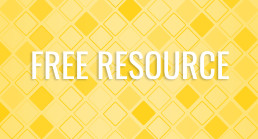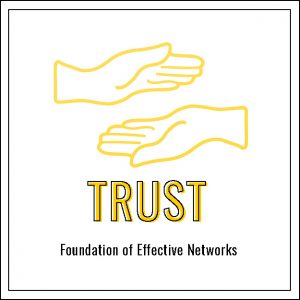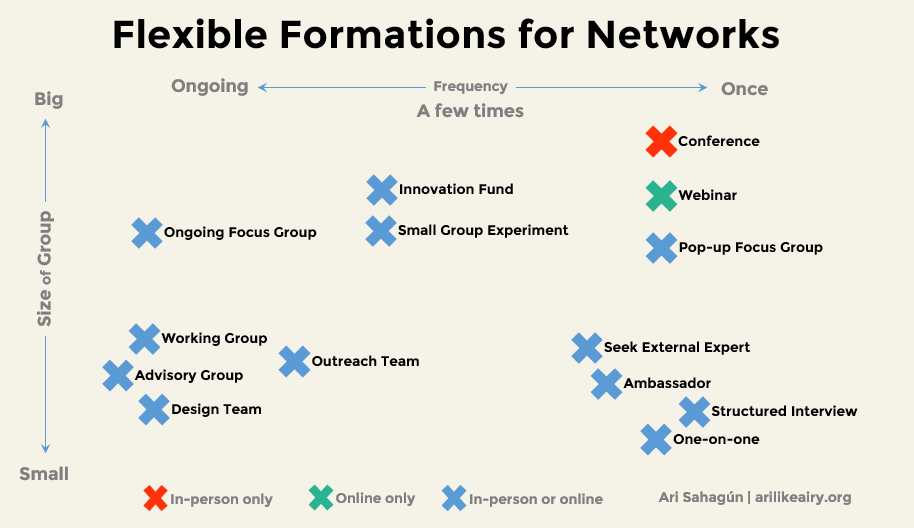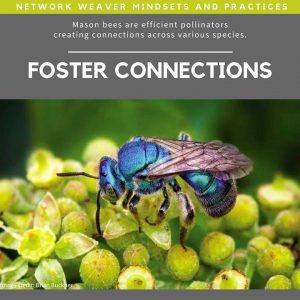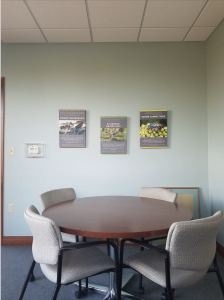Trust: Foundation of Effective Networks
November 2, 2018Network Weaving,Network Support Structures,Network Structure and Governance,Network Mindset,Network Processes,Blog
This article is a chapter from the Network Weaver Handbook with several worksheets you can use with your networks, projects and organizations.
They go together nicely with the blog posts Trust in Networks is Fundamental to Social Change by Christine Capra and Trust in Networks by June Holley.
[ap_spacing spacing_height="20px"]
Flexible Formations for Networks
October 29, 2018Self-Organizing,Network Support Structures,Network Structure and Governance,Blog
[ap_spacing spacing_height="20px"]
Thinking about co-design embedded within a network presents additional challenges. Ideally, a design team creates many spaces to engage in co-design – both online and in-person – that allow for maximum input and creativity as well as respond to shifting levels of availability/capacity to participate.
What follows is a brainstorm I did with my sister, Licia, of the list of formations (groups within a network) that enable this. Furthermore, these formations can be organized from a central group - like a design team - or self-organized as they emerge from network members. [ap_spacing spacing_height="20px"]
[ap_spacing spacing_height="30px"]
| Formation | Definition |
| Advisory group |
Small group that lasts for the length of the project to advise and provide context for the design work; similar to design team but broader
|
| Ambassador |
One person does a one-on-one, then takes on work to do other one-on-ones, or takes information to broader group; “train-the-trainer” might fit here
|
| Conference |
Large group comes together with potential breakout groups, usually in-person
|
| Design team |
An ad hoc group that meets throughout the duration of the project (or sub-scope within it) to provide planning insight
|
| Innovation fund |
Selected group of projects that are funded for specific outcomes
|
| One-on-one |
A conversation between two people
|
| Ongoing focus group |
A representatively diverse group of people assembled to participate in a guided discussion about a particular product before it is launched, or to provide ongoing feedback on a political campaign, television series, etc.
|
| Outreach team |
Spreads the word about design process and reflections to rest of network
|
| Pop-up focus group |
A representative group of people that meets once to provide structured feedback on a specific topic
|
| Seek external expert |
Someone reaches out of core network for advice or thought leadership
|
| Small group experiment |
An ad hoc group that meets to engage with and provide feedback on a project, product, or part of it
|
| Structured interview |
A one-on-one with very specific outcomes
|
| Webinar |
An online lecture with potential Q+A
|
| Working group |
Small group of people who meet regularly with specific outcomes in mind; could be called a committee.
|
[ap_spacing spacing_height="20px"]
We encourage you to comment on this post so we can hear about your thoughts and experience.
[ap_spacing spacing_height="20px"]
Originally published at arilikeairy.org on March 26, 2018
[ap_spacing spacing_height="30px"]
Network Governance
October 29, 2018Self-Organizing,Network Support Structures,Network Structure and Governance,Blog
[ap_spacing spacing_height="20px"]
Network governance is the idea that decision-making that is currently lodged in representative bodies such as congress or city councils can be shifted into self-organizing networks. This shift has the potential to massively increase participation and inclusion in policy making and, at the same time, ensure that policy making becomes more innovative, experimental, and capable of learning and transformation. Network governance has the potential to enable all of us to be part of co-creating a world that is good for all of us.[ap_spacing spacing_height="10px"]
Network governance can generate forms of governance that are equitable and inclusive, quick and creative in responding to issues and problems, and capable of tackling the complex and planet-threatening issues of our time.[ap_spacing spacing_height="10px"]
For example, food policy councils, at their best, are cross sector networks that include residents, government and educational representatives, non-profits and food related businesses. They research policy options for things such as rules regarding urban chickens, handling of food waste and support for community gardens, adapt these policies to their locale, and then present policy suggestions to city councils. It seems a small step to empower such councils to make the decisions themselves.[ap_spacing spacing_height="10px"]
Several new developments have made the shift to network governance possible.[ap_spacing spacing_height="25px"]
Self-organizing structures[ap_spacing spacing_height="15px"]
First, new self-organizing structures for network governance are being piloted. These include organizing decision-making into (usually small) work groups called circles: a small, diverse set of individuals who interact as peers and who care deeply about an issue take responsibility for a specific policy initiative - anyone can join the circle. The circle researches the issue and often engages many additional people in a co-design process to generate a draft policy proposal (through the use of technology which is discussed in the following section). Governance networks may have hundreds of circles operating at any one time, with many people involved in more than one circle. [ap_spacing spacing_height="25px"]
Innovative decision-making processes[ap_spacing spacing_height="15px"]
Then the circle uses an innovative decision-making process such as co-design, advice or consent. In the advice process, anyone who would be impacted by the decision has an opportunity (with a deadline) to give feedback on the proposal, which the circle tries to incorporate. The circle has final decision-making power, though if the proposal is controversial the time set to review the policy will be short. The idea is to try something out that is “good enough for now.” [ap_spacing spacing_height="20px"]
[ap_spacing spacing_height="20px"]In co-design or co-creation processes, diverse participants come together and design a new way of doing something, with decision-making woven into the design process, which then moves directly into a pilot phase. For example, a group of residents and organizations may join together to set up a new structure, such as an Innovation Fund that provides seed funds to community projects. This expands the definition of policy making to any collaborative act that contributes to community co-creation. Sometimes co-design is combined with advice or consent processes.[ap_spacing spacing_height="10px"]
Circles and advice/consent processes are currently being used in hundreds of innovative businesses and are now being piloted in a increasing number of networks.[ap_spacing spacing_height="25px"]
Helping participants shift to network values[ap_spacing spacing_height="15px"]
Network governance only becomes transformative when the underlying culture shifts. Network values/behaviors include interacting as peers, dismantling hierarchy and racism, embracing diversity and inclusion, letting go of control, becoming comfortable with uncertainty, seeing everything as an experiment, having space for reflection and learning. Network participants are much more likely to be able to make these shifts in the intimacy of circles, where they can track their progress on these through simple group surveys, then get support for change.[ap_spacing spacing_height="15px"]
The use of technology[ap_spacing spacing_height="10px"]
Next, the use of technology is making cross sector participation possible. Using zoom video conferencing sessions with breakout rooms for discussion combined with the use of google docs for gathering ideas, reflections and feedback makes involvement of many people possible. This can be combined with prioritizing and polling platforms such as sli.do and platforms such as loomio and participative budgeting platforms. In addition, innovators such as vTawain have used other platforms such as polis.[ap_spacing spacing_height="15px"]
Networks of networks[ap_spacing spacing_height="10px"]
The third development is the development of networks of networks for sharing, spreading and learning. These networks of networks are often focused on a specific issue area. For example, the hundreds of food policy councils in the U.S. have state networks, and the state networks are linked through a national network. Both state and national networks have frequent virtual (and occasional face-to-face) learning sessions where they share insights and strategies about specific policy areas and about other topics of relevance. Other networks of networks are perfecting communities of practice or learning clusters so networks are supported in their efforts to do system shifting work. [ap_spacing spacing_height="10px"]
Other networks of networks are convened around cross cutting issues or are bringing people from different (sometimes related) issue areas together for more systemic understanding. For example, Robert Wood Johnson Foundation has been convening networks working on different system elements it calls the Culture of Health (food access, housing, wellbeing, prison pipelines, etc). Other networks of networks are convening to learn more about networks and transformation or about racial justice and equity. These create pathways for viralness, large scale impact and transformation. For example, the use of zoom has spread through the nonprofit world at lightning speed, dramatically increasing the amount of collaboration happening.[ap_spacing spacing_height="15px"]
What would it look like?[ap_spacing spacing_height="10px"]
Imagine policy councils for every aspect of life: housing, health, recreation, education, etc. with most people involved in 2-3 circles at a time but providing advice on dozens or hundreds of proposals a year.
Most governance networks are likely to be local or regional. However, it would be exciting to explore how the networks of network might work nationally and internationally to solve huge, complex problems.[ap_spacing spacing_height="15px"]
How do we get there?[ap_spacing spacing_height="10px"]
Many networks already exhibit some but not all of the characteristics of network governance. By working as a catalyst network, we can help interested networks move to a more complete network governance form. We can create a network of networks interested in moving their networks to the next level and jointly develop a model of key elements of network governance, including case studies of network governance in practice.[ap_spacing spacing_height="10px"]
Also see https://docs.google.com/presentation/d/1I77C0T0UH5b0ZrMsb-QiIBjJkT1G1LlmotrQa1iK1jE/edit?usp=sharing
[ap_spacing spacing_height="25px"]
We encourage you to comment on this post so we can hear about your thoughts and experience. [ap_spacing spacing_height="40px"]
Network Weaver Mindset Posters
October 26, 2018Network Mindset,Blog
Ari Sahagun and Odin Zackman co-designed seven posters on Network Weaver Mindsets -- fresh with ecological metaphors. Feel free to use them in your work!
We'd love to hear your thoughts and comments below!
Here is an example of how they look printed and posted on a wall. These are from Freya Bradford of Rotary Charities of Traverse City.
[ap_spacing spacing_height="15px"]
What’s With The Network Weaving Thing?
October 24, 2018The Field,Network Weaving,The Big Picture,Blog
[ap_spacing spacing_height="20px"]
I became a rabble-rousing, injustice-fighting, demonstrating, boycotting, marching, chanting, banner-carrying, strategizing, counter-culture activist early
– by age 13 I’d faced my first line-up of National Guardsmen un-accompanied by any adults who knew me.
By my mid-20’s, though, I was utterly disenchanted. The issues were still real & unacceptable, but activism had proven ineffective. Nothing ever really changed.
The direct-attack approach just burned through energy and resources, without getting anywhere near the roots of the problems. We were all too far outside the systems that needed to change – those systems were too well-protected.
Activists were hysterical misfits attaching themselves aimlessly to random causes, more for the adrenaline & thrill of disruption than out of commitment to anything in particular. I tired of the endless power-struggles, and people projecting their own unacknowledged emotional problems onto larger social issues (which, you know, maybe I was still doing a little of that myself. . .).
Plus, by then I was a single mom & needed to support my kid. I settled down, quit tilting at windmills and became pragmatic. Well, I tried to anyway.
Ultimately, I discovered that activists were no more dysfunctional than other groups – they just had fewer carrots & sticks to keep things focused was all.
My need to make things better shrank down to the confines of my employer organizations & specific work-related initiatives, but even so, change was hard work. And regardless of context, carrots & sticks seemed crappy substitutes for passion, intrinsic motivation and vision.
[ap_spacing spacing_height="20px"]
Some questions can’t be avoided
So the question still was – how can groups of people work together more effectively to solve problems – without coercion? And without the financial reward that imposes it’s own priorities, and inherently skews solutions toward the market, whether market solutions are appropriate or not? Or maybe more to the point – how do you access the passion & motivation & vision inherent in all would-be change-agents in a way that helps them fulfill their own personal missions while still moving toward larger collective goals?
I contemplated those questions so long that I decided to get a Master’s Degree in Organizational Leadership – and discovered Wheatley, Senge, Bohm, Scharmer, Kahane, Meadows, Semler, Argyris and so on & so on & so on.
I found a whole new world of systems thinking, collective wisdom, dialog, self-organizing systems, complexity – it all was exactly what I’d been missing all those years. I was in intellectual heaven, completely engrossed. I felt like I’d found the key to the Universe.
At first I tried to apply what I was learning in my work-place – not so successfully. Eventually I realized that profit-oriented hierarchies aren’t the best fit for the approaches I was interested in. I wasn’t positioned to change the secretive, hoarding, clinging, fearful, linear, bottom-line, controlling minds at the top – and eventually realized it was stupid to even want to – just more tilting at windmills.
I moved on to experimenting in the real world – in loose groups gathering around causes & ideas, collectives trying out new ways of working together, etc.. This was a better fit, a more conducive context. But still, collectivity & change were hard.
There were all these lovely new methodologies – Appreciative Inquiry, World Café, Open Space Technology, Dialog, Theory U, Human Systems Dynamics, Scenario Planning, Theory of Constraints, Design Thinking, etc., etc. – most of which, though wonderful, seemed best suited to more bounded & narrowly defined situations. Or are applicable to smaller groups, or larger groups. Or less diverse groups, or ones with smaller gaps in privilege & equity, Or they require a ton of time, money, expertise and planning. Or they’re so conceptual & abstract that people mired in real-world, right-now issues just can’t focus on them long enough to give them a chance. Or else . . .
[ap_spacing spacing_height="20px"]
I’d found a key, but for which door?
I wasn’t looking for the keys to corporate change – I was stalking change & emergence in self-selecting groups attempting to make huge differences. I was back to my activist roots, wanting to solve the big, big problems, like poverty & ecological sustainability, white supremacy & urban livability & climate change. Big overlapping, complex problems that require collaboration & passion across all kinds of differences. Problems that demand more than one vision, myriad visionaries, multiple strategies & that won’t oblige central command & control.
And the thing is – the answers are still emerging. There’s a ton of good work going on, but everyone is still learning. There’s no one size fits all. We’re not ‘there’ yet (if ‘there’ even exists anymore, or ever did).
Anyway – all of that above is my long-winded way of telling you my bona-fides, my credentials – why I feel qualified to say what I’m going to say next. Which is:
Network Weaving is darn close.
So, if Self-organizing is the key, then Network Weaving is the lock and the door & the turning bolt & the handle & the hand & the doorframe & the. . . you get the point. I don’t mean it’s the only key, or the be-all or end-all. But it’s scalable, flexible & fits a lot of contexts.
I wouldn’t have suspected that.
[ap_spacing spacing_height="20px"]
I didn’t start out all that psyched about Network Weaving.
It just seemed like another relevant but small piece of the puzzle – of course you need networks, but there’s a lot more to it than that. . . (I think I was still enamored of complexity – I wanted it to be more sublime).
But no – I got to Network Weaving through my background in data analysis, gathering & visualization – I mapped some networks. For money. It was just another opportunity to fiddle on my computer, mess with spreadsheets & make something pretty (a tech-y version of pretty that is) – which is one part of what I’ve done for a living for awhile now.
But it did amplify, in my own mind, the one thing that became crystal clear in all my earlier experiments – just inviting a lot of folks & getting them to the table isn’t enough. Even with all those beautiful methodologies.
If the quality of the connections isn’t high enough to get meaning & value flowing – you just have a lot of happy-talk. And disenchantment. And no change. In spite of shared vision & simple rules & all those other important components.
It all still comes down to the foundation – the interdependence that bonds us together.
If the human bonds at the core of the system aren’t strong & trusting, not much new will happen. And Network Weaving is all about creating, not just connections – but connections that can carry weight. It’s about meaningful connections, resource-sharing connections, mutual-aid & mutual-growth & mutual-survival connections.
So Network Weaving as the way into Self-Organizing just kind of grew on me.
And network mapping as the way into Network Weaving started to seem inevitable – work I had to do.
And I don’t mean just Social Network Analysis (SNA). No, SNA was just another game for data-dweebs. Used in organizational decision-making & marketing & fundraising & influence peddling – also good for researching disease transmission and terrorist cells and other scientific purposes.
No – I quickly became interested in a specific application of Social Network Analysis, and only as a small piece of what I imagined was possible through interactive network mapping.
What became meaningful & exciting to me was the potential for self-organizing & transparency & real resource exchange (just like in a living system) that an interactive, online network map could facilitate. Interactivity promised to enhance the conditions necessary for self-organizing. And while I was trying to figure out cheap ways of making the tools I had at hand more interactive, Kumu.io made a huge leap in that very direction & provided the perfect platform for what I was dreaming up. Which clinched the deal, that was my entry point. A method I could finally get behind & settle into. It was time to absorb everything I could about the Network Weaving methodology.
And, as I did, I started to see that Network Weaving contains the skills, the process & the methods to help self-organizing come into being (without bogging down in theory).
Network Mapping is just one part of the whole picture – the part my husband Tim & I are especially qualified to help with. But I have learned enough about self-organizing & systems & complexity & human trust and passion and intransigence, to recognize that Network Weaving, combined with a good interactive network map designed around your particular network’s specific needs, has the potential to break through all that ineffectiveness that frustrated me about back-in-the-day activism.
It’s not the only or the final answer, but I don’t think you can go wrong to include network weaving & a network map in your collective change efforts. And the purpose of this blog is to help with that.
What’s your experience with Network Weaving? And how could I help enable your network weaving & mapping practice? Please comment below.
[ap_spacing spacing_height="20px"]
originally published at Greater Than The Sum on June 24, 2015
Call to Create
[ap_spacing spacing_height="25px"]
Why a Call to Create? Visual art, performance, poetry, music, and other forms of art and creativity connect us. Art is an expression of our realities, and of our hopes, dreams, and vision for the future.
[ap_spacing spacing_height="25px"]
THE INVITATION
Within each of us, we have a vision of a different world. This vision is rooted in interdependence, and it’s a way of seeing the world where no one gets left behind. It’s a vision of what we’re for, not just what we’re against.
What if we could get in formation, and co-create the world we want to live in right now? What if it’s already happening? This is an invitation to engage together creatively, to get in formation, to envision the world we want to live in.
[ap_spacing spacing_height="15px"]
[ap_spacing spacing_height="15px"]
Visual art, performance, poetry, music, and other forms of art and creativity connect us. Art is an expression of our realities, and of our hopes, dreams, and vision for the future.
That’s why Resonance Network is inviting you to create art and share it with others. Your creative work will be about the world you want to live in, and can take any form. The invitation is to create an artistic piece that reflects on the following quote:
[ap_spacing spacing_height="15px"]
Reflect on the world of generations that will come after you — what are your highest hopes for how it will look, sound, feel?
[ap_spacing spacing_height="25px"]
HAVE SOME FUN!
Your artistic work might take the form of a painting, poem, sketch, cipher, collage, photograph, story, music, or whatever comes to you in the creative process. Play with a pen and paper, a camera, crayons, collaged images, a microphone, or whatever materials make you excited about the creative process
Find a moment to yourself or invite others — a neighbor, child, grandparent, or friend— into your creative process. Download a printable PDF of this overview and instructions. We ask that you share what you’ve created here.
If you have any difficulties submitting, please contact info@resonance-network.org, and we’d be happy to help!
Network Toolkit for Network Weavers
October 19, 2018Introductions,Education,Network Weaving,Blog
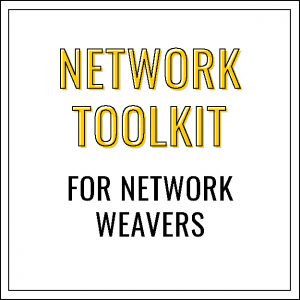 Want to know how start with network building?
Want to know how start with network building?
This free toolkit offers a set of activities you can incorporate into your next gathering to set you on a path to an effective network.
It includes speed networking, PostIt note mapping, closing triangles and other processes that anyone can easily facilitate.
Stories of Network Value and Engagement
October 17, 2018The Field,The Big Picture,Network Mindset,Blog
Every month Network Weaver has a virtual Consultants Gathering. In August's gathering, the consultants were asked to share stories about their own successful and fulfilling network experiences.
Below are three stories from Network Weaver consultants in response to this question:
“What is a story of a time that a network offered you value and you were excited enough to prioritize engagement with that network? What were the conditions that enabled this?
[ap_spacing spacing_height="30px"]From Aisha Shillingford
A few years ago I was a member of a national network of people working for spiritual and social transformation. Prior to joining I had become aware of the network and felt greatly impressed and inspired by the way the members of the network embodied practices that reflected the values and principles of the network. I deeply desired to join so I could be part of this community that was walking the talk and making a positive impact in the lives of others. I remained part of the network for over ten years.
Reflecting on the conditions that enabled my sustained involvement I thought of the following:
- a clear network structure that allowed people to be involved in the network at different levels of engagement and responsibility.
- a community of support and accountability
- a joyful and meaningful connection to members of the network, true friendships
- a clearly and oft articulated purpose and vision
- opportunities for learning and for contributing to the growth of others
- personal and social development. Self development as well as projects for improving the broader community
- a strong sense of ‘we’, a shared identity
- clear mechanisms of appreciation and votes of trust. These were shown through increased responsibility and participation in decision making etc.
[ap_spacing spacing_height="30px"]From Curtis Ogden
The network that immediately comes to mind is the network I’ve been supporting for almost 7 years now, Food Solutions New England. Though I am technically a consultant, at this point I am very much a member of the family. It was, in some sense, exactly what I was looking for – a “project” to really sink my teeth into and a community where I could find a deeper sense of belonging.
I would say that from the get-go there was something about the quality of the people, the sense of welcome, and of being more authentic and whole with one another that was a draw. People were willing to not just be in their heads, but in their hearts and souls. We shared meals and informal conversation with one another. We shared art and poetry. And there was a sense of truly being in something bigger, a movement, that was larger than any of our individual work. So, trust, authenticity, openness, and compelling purpose all helped.
We have also been committed to diversity, inclusion and equity in a number of different ways, so that there is a commitment to ongoing learning and action, which results in being in rooms with people of a variety of different backgrounds and identities, which is stimulating. Over the seven years of work, there have been threats of plateauing and then we come on another challenge: from building a base of trust, to aligning around a vision, to committing to racial equity, to mapping our system to working on complex solutions, to addressing white privilege and white supremacy culture. Never a dull moment? And we have consistently evolved the structure to meet the needs of where we were moving and growing towards.
I consider the people in this network to be friends, many of whom would really have my back. In this day and age, that feels like an incredible gift.
[ap_spacing spacing_height="30px"]From Kiara Nagel
The network that comes to mind is an international youth network I have been connected to for 10 years now. Focused on internal development and external social initiatives, the network has spun off several different initiatives led mostly by 18-28 year olds.
I think what makes people excited to be involved are:
- deep friendships and many different relationships
- many opportunities for different experiences to collaborate creatively with one another to develop our practices
- collective work that benefits, connects to, and serve others.
There is also an evolving core that brings people back together from time-to-time and shared attention is given to how the economy is developed and the values are practiced
Read more stories in Monday's blog post.
If you have a story you'd like to share, please do so in the comments below, or email info@dev.networkweaver.com
Stories of Network Value and Engagement
October 15, 2018The Field,The Big Picture,Network Mindset,Blog
Every month Network Weaver has a virtual Consultants Gathering. In August's gathering, the consultants were asked to share stories about their own successful and fulfilling network experiences.
Below are three stories from Network Weaver consultants in response to this question:
“What is a story of a time that a network offered you value and you were excited enough to prioritize engagement with that network? What were the conditions that enabled this?
[ap_spacing spacing_height="30px"]From Yasmin Yonis
At one point some years ago, I was actively engaged with my Truman Scholars Network — listserv posts, meet ups, attending conferences. I was engaged because it was a network of people who shared the same values and same goals as I did—a career in public service—and were passionate about helping each other reach those goals. There was a sense of community and solidarity. We had all survived the infamous Truman selection process and we were in this together. Trumans were in every career field, many of them higher up, and could help you secure connections with others, internships, jobs, and provide help during the graduate admission process. I found some of my best friends in this network.
[ap_spacing spacing_height="30px"]From Sara Shapiro-Plevan
In November 2017, a network of women who had been victims of gender bias or sexual harassment in the workplace, specifically in Jewish communal settings (synagogues, Jewish schools, and Jewish organizations) began to coalesce. Some of us met in a large group in late November and began to self-organize in small groups around particular areas of urgency or interest. For some of us, current events were enough to motivate us to gather, to talk together, and to learn to listen and respond to each other differently. For others, having been victims or caring for victims propelled us to engage with the network and connect with others. Current events swirling around us were no doubt also a motivating factor that we all used to catalyze our engagement with this developing network and our desire to weave the network into something tighter.
We also knew that without the power that lived within this network--predominantly female and with some men who were allies--we would continue to see a culture of complaint without action emerge, and this would be ultimately unsatisfying. Small spots of action began to emerge within the network, through the relationships that came about inside the network amongst trusted network members. Those outside the network were not deemed as trustworthy as those inside--not trustworthy enough to take part in various actions or to hold the stories of those inside the network.
Half a year has passed and real action has emerged from the group. Ideas which were born inside the network have become professional training for people in organizations on the periphery as the changes the network is seeking are becoming diffused. Those trainings are using network models to make sure that they do not stay as trainings alone but create a strong community of partners who can get the work done after they are trained to make change. Advocates from inside the network are moving from the core to the periphery to carry the messages of this work and the value and need for change out into the world and acting as powerful bridges.
Certainly, this is based on current events. When the world can see women as equal and workplaces as equitable, maybe these networks that are being born and coalescing will disappear. But women are taking the reins here and giving birth to these networks, shaping them and making sure that they are strong, using network principles even where they do not know them, and evolving them into something truly captivating.
I myself found two friends inside this network who wanted to work on a project with me, and we have woven our own network as a part of the larger one around hiring as a specific focus, gathering professionals who have been impacted specifically by issues connected to hiring processes. The energy that has been generated inside this has surprised me--it has not been anger alone but has been directed toward change. Where it could have been anger, the network managed to, as a living and breathing entity, steer toward growth and positivity and appreciation, and we are all energized toward a future that can be about connection and equity over disconnect and imbalance.
[ap_spacing spacing_height="30px"]From Joni Bryan
I was fortunate enough during my undergraduate work to be matched with a network weaver extraordinaire as a mentor, Dr. Froswa’ Booker-Drew. Although my networking had been effective previously, it was almost entirely intuitive, and she added science and strategy to it. She also trusted me enough to introduce me to those in her network who could help, or who I could help, and modeled network weaving for me. She introduced me to the idea of social capital and leveraging relationships to make change. Years later, she is still a mentor and a friend to me, and has taught me that every relationship has value and how to strategically align my community to make change. I started a nonprofit community after that, Amplify, and today it is 5 years old and 5000+ members strong - we all rely on each other for the collective knowledge and skills we could never have alone!
More stories to come in Wednesday's blog post.
If you have a story you'd like to share, please do so in the comments below, or email info@dev.networkweaver.com
Network Weaver Free Resources Package
October 12, 2018Network Weaving,Network Support Structures,The Big Picture,Reflection and Learning,Network Structure and Governance,Introductions,Network Mindset,Innovation,Network Processes,Self-Organizing,Blog,Education,The Field,Network mapping
Each week, we add a new free item to our store.
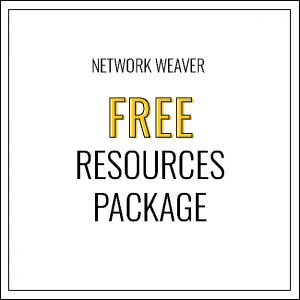
This week we are offering: Network Weaver FREE RESOURCES PACKAGE.
ALL of the free resources currently available at the Network Weaver Resource Page in one complete downloadable file.
